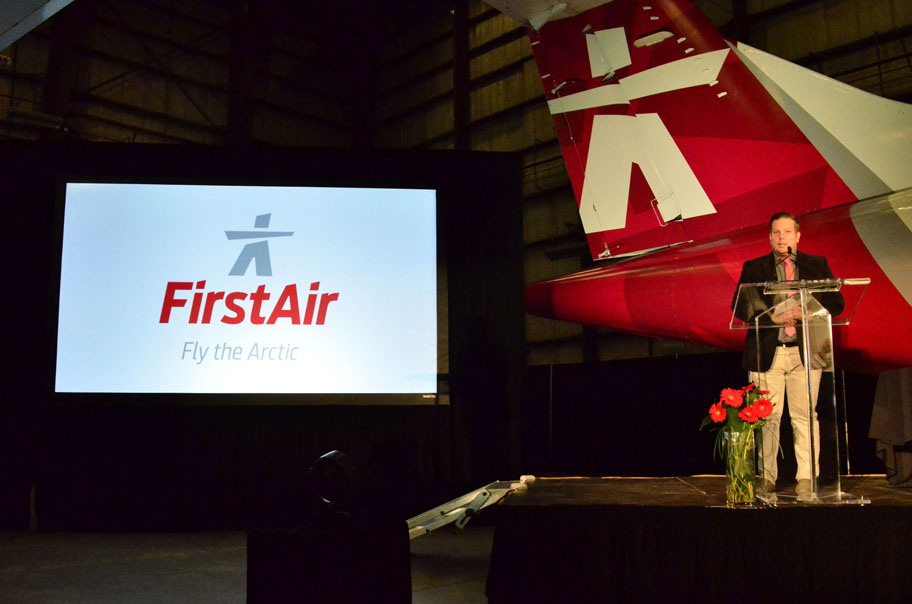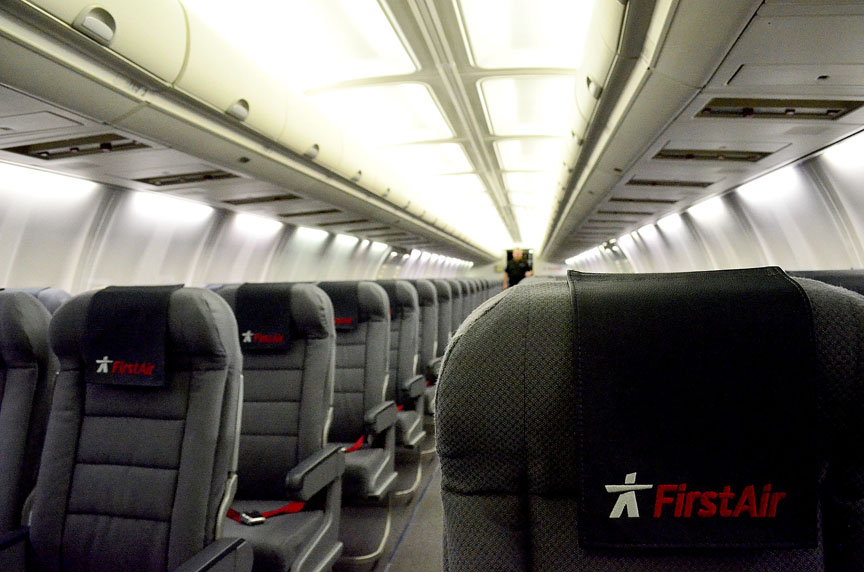Rebranded First Air celebrates a rebirth

After unveiling new livery, new uniforms, new branding materials and a new catch-phrase, a reorganized First Air is ready to expand and seek new Arctic business opportunities, company officials said Oct. 12.
“We are talking about the rebirth of the airline,” First Air’s president and CEO, Brock Friesen, said at a crowded promotional event held inside the airline’s hangar at the Ottawa International Airport.
At the same time, Friesen and Johnny Adams, the chair of First Air’s board, each slammed the Government of Nunavut’s Nunavummi Nangminiqaqtunik Ikajuuti, or NNI, procurement policy, saying it fails to recognize First Air’s social and economic contributions to the territory.
Although First Air is owned by Nunavik Inuit through Makivik Corp., it does not qualify as a Nunavut Inuit owned firm for the purposes of the NNI.
“The policy unfortunately does not apply to the scheduled airlines… I wish the government would revisit it. We hope things will change,” Adams said in a speech given to an audience of First Air board members and employees, federal civil servants, Ottawa airport officials, airline executives and other invited guests.
Friesen said the NNI policy does not take into account First Air’s considerable investment in Nunavut where, in most communities, they maintain costly ground infrastructure and have become an important private sector employer.
“It really upsets me,” Friesen said, in an interview with Nunatsiaq News.
And he said it’s frustrating for First Air to watch southern-based charter airlines, who don’t have to worry about high northern overhead costs, walk away with contracts without having to make any investments in Nunavut.
At the same time, Adams and Friesen suggested that in the future, First Air and Qikiqtaaluk Corp. may revive the former joint-venture partnership that led to the creation of Qikiqtani First Aviation Ltd., or QFAL.
That partnership is now dormant and its listing on the GN’s NNI website has now expired.
But acknowledging the presence in the audience of “our partners,” Harry Flaherty and Olayuk Akesuk of the QC, Adams said in his speech that First Air hopes, once again, to turn their relationship “into an actual partnership.”
Friesen later said that it’s too early to say if the two companies have started negotiating, but it is the case that they are now “of one mind.”
First Air used the Oct. 12 marketing event not only to show off its new bright red, white and grey livery, but also to project a new image and declare the company is now profitable and hungry for new business opportunities.
A stylized image of an inuksuk, white on a red background, now appears on the tails of First Air’s ATR and Boeing 737 aircraft, representing the airline’s Arctic identity.
That identity is captured in its new catch-phrase: “Fly the Arctic.”
Friesen said most people around the world consider places like Ottawa, Edmonton and Yellowknife as “northern” and part of the “North.”
“But we are the Arctic,” Friesen said.
Adams also said it represents “ukiutaqtuq,” or the Arctic, and to that end, said the airline hopes to help build tourism opportunities in Nunavik, Nunavut, Nunatsiavut and Greenland to help “fill those empty seats.”
The dominant color you’ll see on First Air’s aircraft is a deep shade of red, especially on the tail sections and engine cowlings of their ATRs and 737s.
The airline’s name, First Air, appears in the same shade of red on the fuselages of their aircraft, using a sans-serif italic typeface.
They’ve also redesigned the interior of their aircraft using grey and red as the dominant colours, and created new uniforms for their flight crews based on the same design elements.

The 71-year-old First Air has its roots in Bradley Air Services, a flight training and bush plane company founded by Russ Bradley in 1946. In 1973, Bradley Air Services began a scheduled service linking Ottawa to North Bay and Sudbury, which they called First Air.
First Air was expanded to bases in Iqaluit and Resolute in 1975 and eventually became a dominant northern air carrier, especially after 1986, when they acquired a Boeing 727-100C jet for use on north-south scheduled services.
In 1990, Makivik bought Bradley Air Services and have operated First Air ever since as a privately-held asset.
About four years ago, First Air entered a rebuilding and restructuring period when Friesen started with the company as CEO.
“Change was necessary to turn this company around,” Adams said.
But now, First Air appears to be financially healthy. On Oct. 11, Makivik said in a news release that they have received a $3 million dividend from the airline.
And earlier this year, the airline got a boost when they won the Arctic Co-operatives Ltd. freight contract.